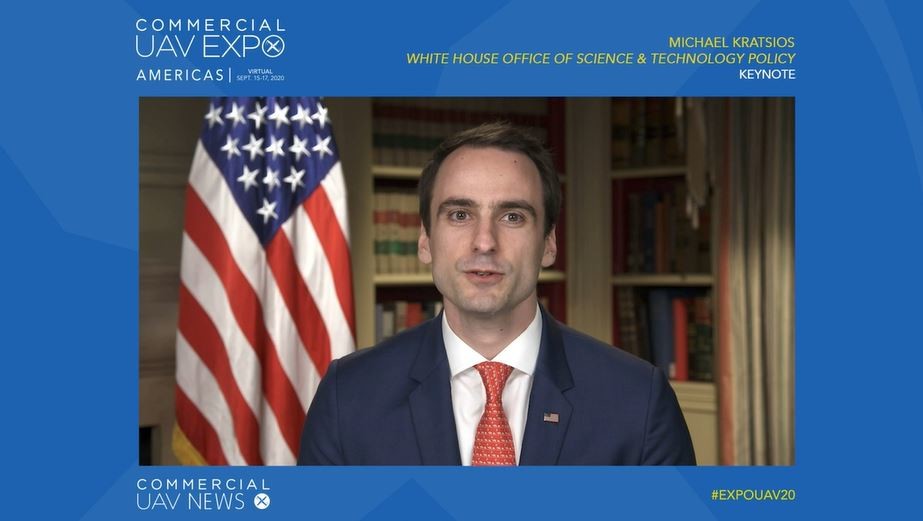On the second day of Commercial UAV EXPO 2020, which took place remotely on Sept 15th through 17th, the proceedings began with an update from Michael Kratsios, Chief Technology Officer of the United States, in an opening session moderated by Lisa Ellman, Executive Director of the Commercial Drone Alliance (CDA).
Lisa began the keynote section by introducing the efforts of the CDA on behalf of all its members.
“CDA is thrilled to partner with Commercial UAV Expo to organize the premiere trade show for our community and for the commercial drone industry in particular,” She said. “We are an independent, non-profit organization and our focus is moving the commercial drone industry forward. We also work hard to promote urban air mobility and advanced air mobility efforts forward. The CDA is working with NASA and the FAA to advance the cause of commercial unmanned aerial vehicles (UAVs) operators in the USA who are in need of expanded operations in the national airspace.”
Lisa mentioned that the CDA had officially responded to the request for comments on FAA’s Remote ID Notice of Proposed Rulemaking (RID) and were following up closely with the agency for an announcement later this year.
“From the Commercial Drone Alliance perspective, this Remote ID rulemaking effort is vitally important, as expanded and scalable UAS operations are key to unlocking the enormous potential of commercial UAS operations here in the United States.”
Lisa pointed out that even though the CDA expressed some concerns about the RID, they remain optimistic that the major issues can be remedied. Lisa also mentioned that the CDA is involved in the drone type certification discussions with the FAA and they are optimistic we will see some promising news soon on that front.
“We have prepared, and this week published, our 2021 Policy Priorities paper for the next president in order to make sure the new administration understands the importance of the industry and its potential impact on the economy.” Ellman stated. “The next administration will have a significant opportunity to leverage and enable the fast-growing commercial drone marketplace for the benefit of all Americans.”
The paper contains a series of concrete actions for the first 100 days to make sure the country continues to lead worldwide efforts to contain the virus and stay healthy.
“If your company is not a member of the CDA, I invite you to join us. Details are on our website.” She concluded.
Lisa then introduced Michael Kratsios, who proceeded to outline the White House efforts on behalf of the unmanned vehicle industry.
“When I joined the current administration in 2017, we identified UAV’s as one of the first emerging technology priorities. I first attended the Commercial UAV Expo in 2018, and since then the industry has exploded and nearly doubled from roughly one million registered drones to almost two million. To put this growth in perspective, it took nearly 100 years to reach 320,000 registered manned aircraft,” began Kratsios. “We have also seen an explosion in the number of remote registered pilots. From 74,000 in 2017, this number has ballooned to over 190,000 certified pilots today. The FAA have also authorized 506 emergency authorizations for UAS to assess damage after hurricanes.”
“The future of commercial drone innovation is here in America,” continued Kratsios proudly. “We implemented the IPP program to accelerate the integration of UAVs into the NAS and explored the possibility of permitting flights beyond line of sight (BVLOS) and operations over people (OOP). In 2019, the FAA issued the first Part 135 commercial UAV operation certificate and just recently it issued its third such certificate, paving the way for the normalization of commercial unmanned operations in the NAS, including the delivery of goods BVLOS. The FAA has also released the initial Remote ID Notice of Proposed Rulemaking (RID) and received over 53,000 comments which are being analyzed in an effort to publish clear rules of the road for UAS operators.”
In his final comments, Kratsios made emphasis on the future.
“The White House is committed to promoting a robust and trusted domestic UAS industrial base,” stated Kratsios. “In August the Department of Defense (DoD) announced the availability of five USA manufacturers small UAS options for the military and all federal agencies.”
Michael concluded his remarks by stating “Once UAS technology is fully realized, it will drive US economic growth and promote the safety and security of the American public.”




.png.small.400x400.png)










Comments